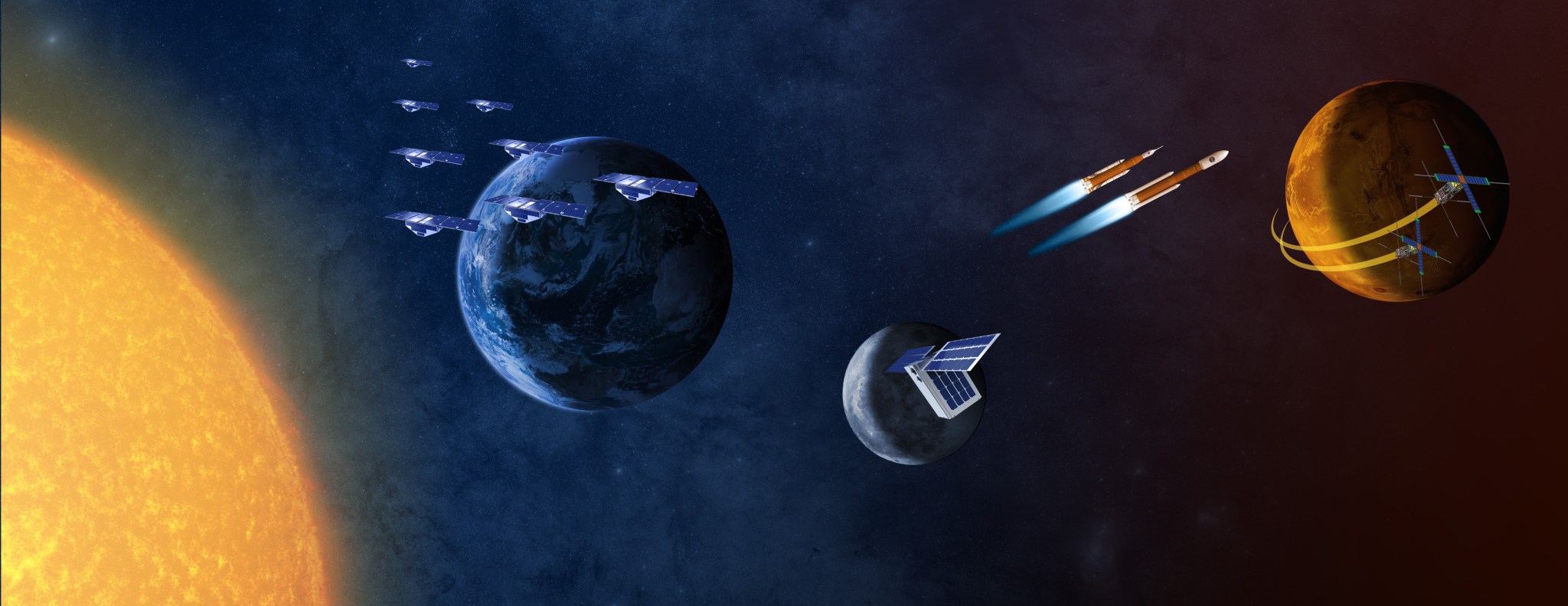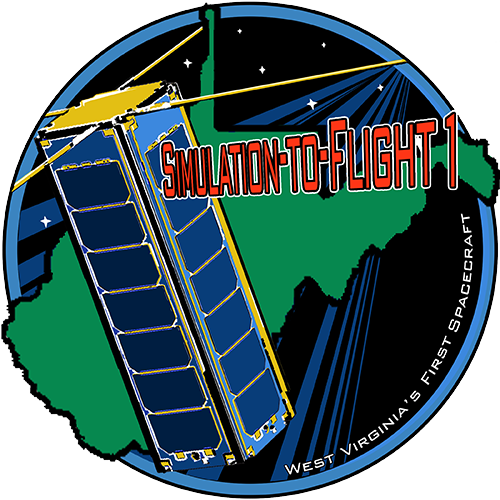NASA’s Near-Earth Asteroid CubeSat Goes Full Sail
September 26, 2017 – ASA’s Near-Earth Asteroid Scout, a small satellite the size of a shoebox, designed to study asteroids close to Earth, performed a full-scale solar sail deployment test at ManTech NeXolve’s facility in Huntsville, Alabama, Sept. 13. The test was performed in an indoor clean room to ensure the deployment mechanism’s functionality after recent environmental testing.
NASA Small Satellite Promises Big Discoveries
September 19, 2017 – Small satellites provide a cheap, responsive alternative to larger, more expensive satellites. As demand grows, engineers must adapt these “nanosatellites” to provide greater data returns. NASA, in collaboration with educational partners, targets 2021 for the launch of an innovative CubeSat that addresses these challenges.
NASA Announces New Collaborative Partnerships with U.S. Industry to Advance Commercial Space Technology
September 1, 2017 – NASA announces 10 new collaborative partnerships focused on U.S. industry-developed space technologies that can advance the commercial space sector and benefit future NASA missions through the Announcement of Collaborative Opportunity (ACO) solicitation released by NASA’s Space Technology Mission Directorate (STMD).
NASA Studies CubeSat Mission to Solve Venusian Mystery
August 15, 2017 – Venus looks bland and featureless in visible light, but change the filter to ultraviolet, and Earth’s twin suddenly looks like a different planet. Dark and light areas stripe the sphere, indicating that something is absorbing ultraviolet wavelengths in the planet’s cloud tops.
NASA’s CubeSat Launch Initiative Broadens Access to Space for Educators, Nonprofits
August 3, 2017 – Accredited education institutions, nonprofit organizations, and NASA centers can join the adventure and challenges of space while helping the agency achieve its exploration goals through the next round of the agency’s CubeSat Launch Initiative (CSLI). Applicants must submit proposals by 4:30 p.m. EST, Nov. 21.
NASA Set to Launch Dellingr; CubeSat Purposely Designed to Improve Reliability of Small Satellites
August 2, 2017 – NASA scientists and engineers named their new CubeSat after the mythological Norse god of the dawn. Now, just days from launch, they are confident Dellingr will live up to its name and inaugurate a new era for scientists wanting to use small, highly reliable satellites to carry out important, and in some cases, never-before-tried science.
NASA SmallSat: Deep Space Symposium / Cube Quest Ground Tournament 4
June 7-8, 2017 – The Small Spacecraft Systems Virtual Institute in collaboration with the Space Technology Mission Directorate’s Centennial Challenges Program sponsored the SmallSats Deep Space Symposium / Cube Quest Ground Tournament 4 at NASA Ames Research Center on June 7-8, 2017. The SmallSat Deep Space Symposium offered an opportunity for NASA to share how the Agency is advancing the capabilities of small spacecraft for deep space science and exploration.
Three DIY CubeSats Score Rides on NASA’s First Flight of Orion, Space Launch System
June 8, 2017 – NASA’s Space Technology Mission Directorate (STMD) has awarded rides for three small spacecraft on the agency’s newest rocket, and $20,000 each in prize money, to the winning teams of citizen solvers competing in the semi-final round of the agency’s Cube Quest Challenge. The three winning teams secured space to launch their CubeSats on Exploration Mission-1, the first integrated flight of NASA’s Space Launch System (SLS) and Orion spacecraft.
Cube Quest Challenge Team Spotlight: CU-E3
June 1, 2017 – The shoebox-size CU Earth Escape Explorer (CU-E3) is being assembled by the University of Colorado, Boulder, Aerospace Engineering Science Graduate Projects Class.CU-E3 is designed for a communications technology demonstration mission, slated to travel more than 2.5 million miles into space. As a Deep Space Derby entry, the diminutive spacecraft will reach an orbit of about 10 times the distance between Earth and the moon.
NASA Hosts Media Day for Small Spacecraft Technology and Announcement of Cube Quest Challenge Winners
May 25, 2017 – Media are invited to learn about NASA’s small spacecraft technology development and upcoming launches, and to talk to finalists in the agency’s $5 million Cube Quest Challenge on Thursday, June 8, at 9 a.m. PDT at the NASA Ames Conference Center at Moffett Field, California.
CubeSats Deployed Outside Station’s Kibo Lab Module
May 19, 2017 – Three CubeSats, with the Earth’s limb in the background, are seen moments after being ejected from a small satellite deployer outside of the International Space Station’s Kibo laboratory module on Wednesday, May 16, 2017. The tiny shoebox-sized satellites known as SG-Sat, CXBN-II, and IceCube, will orbit Earth observing the Earth’s upper atmosphere and interstellar radiation left over from the Big Bang. Over a dozen CubeSats were ejected into Earth orbit this week outside the Kibo module to study Earth and space phenomena for the next one to two years.
Cube Quest Challenge Team Spotlight: Ragnarok Industries
May 16, 2017 – Ragnarok Industries is busily working on its Cube Quest Challenge entry, a 6U smallsat named Heimdallr. The spacecraft will feature electric propulsion to reach lunar orbit, explains Luigi Balarinni, chief executive officer and co-founder of the firm. A big plus in their design and building of Heimdallr is partnering with a diversity of space industry companies, furthering their objective of advancing CubeSat applications in the near future.
NASA Team Pursues Blobs and Bubbles with New PetitSat Mission
May 9, 2017 – Figuring out how plasma bubbles and blobs affect one another and ultimately the transmission of communications, GPS, and radar signals in Earth’s ionosphere will be the job of a recently selected CubeSat mission. A team of NASA scientists and engineers, led by Jeffrey Klenzing and Sarah Jones, scientists at NASA’s Goddard Space Flight Center in Greenbelt, Maryland, recently won NASA funding to build the Plasma Enhancements in The Ionosphere-Thermosphere Satellite. The mission, also known as petitSat, is a precursor to a possible Explorer-class mission and leverages several R&D-supported technologies, including the satellite bus itself.
Sweet 16: Goddard Teams Fly Extraordinary Number of Payloads in 2017
April 25, 2017 – As launches go, 2017 is shaping up to be an extraordinary year for technologists at NASA’s Goddard Space Flight Center in Greenbelt, Maryland. Sixteen different missions whose instruments and components were developed at least in part with funding from the center’s Internal Research and Development, or IRAD, program have either launched or are scheduled to launch this year aboard commercial launch vehicles, sounding rockets, balloons, and high-altitude research aircraft.
NASA Invests in 22 Visionary Exploration Concepts
April 6, 2017 – NASA is preparing for a future that could include soft robotic spacecraft with flexible surfaces that can anchor to an asteroid, and an artificial gravity device for long-duration, deep space missions, along with other technologies that so far has been limited to the realm of science fiction.
Vector Space Systems Will Launch Microsatellite Rockets from Florida
March 27, 2017 – Eyeing a projected boom in demand for microsatellites, startup Vector Space Systems on Saturday (March 25) unveiled plans to fly its small launch vehicle from a Florida-owned launch pad at Cape Canaveral Air Force Station.
NASA Selects CubeSat, SmallSat Mission Concept Studies
March 22, 2017 – NASA has selected ten studies under the Planetary Science Deep Space SmallSat Studies (PSDS3) program, to develop mission concepts using small satellites to investigate Venus, Earth’s moon, asteroids, Mars and the outer planets.
NASA Tests Braking Device for Returning Small Spacecraft from Space
March 7, 2017 – After a two-month stay aboard the International Space Station, NASA’s Technology Educational Satellite (TechEdSat-5) that launched Dec. 9, 2016, was deployed on March 6, 2017 from the NanoRacks platform and into low-Earth orbit to demonstrate a critical technology that may allow safe return of science payloads to Earth from space.
NASA Establishes New Public-Private Partnerships to Advance U.S. Commercial Space Capabilities
Feb. 22, 2017 – NASA is partnering with eight U.S. companies to advance small spacecraft and launch vehicle technologies that are on the verge of maturation and are likely to benefit both NASA and the commercial space market.
NASA’s New Shape-Shifting Radiator Inspired by Origami
Jan. 31, 2017 – Japan’s ancient art of paper folding has inspired the design of a potentially trailblazing “smart” radiator that a NASA technologist is now developing to remove or retain heat on small satellites.

































